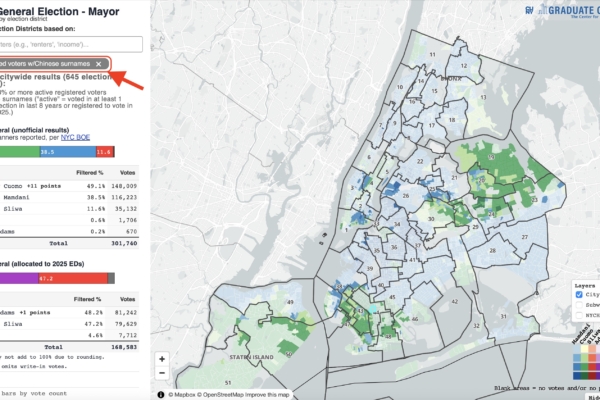In the 2025 New York City general election, a record high turnout was achieved for the first time in half a century. According to statistics from the New York City Board of Elections, over 2.05 million people cast their votes on November 4th, surpassing 2 million for the first time since 1969.
In 1969, liberal mayor John Lindsay was elected with around 2.5 million votes, maintaining the record for the highest voter turnout in New York City to this day. The most active voting year in this century was 2001 when approximately 1.52 million people participated in the election. Billionaire Michael Bloomberg represented the Republican and Independent parties and was elected mayor two months after the 9/11 terrorist attacks.
According to a map created by the CUNY Center for Urban Research based on voting data, this year saw a total of 301,700 Chinese-American voters participating in the election, an increase of nearly 79% from 168,600 in 2021. The breakdown of support among Chinese-American voters was 148,000 for Kummer, 116,000 for Mandani, 35,000 for Sliva, and around 670 votes for Adams.
In terms of percentages, 49.1% of Chinese-American voters supported Kummer, 38.5% supported Mandani, and 11.6% supported Sliva, with Kummer leading Mandani by approximately 11.6 percentage points in the Chinese community.
This analysis covered all 645 election districts (ED) in the city, using the criterion of districts where Chinese surnames accounted for more than 8% of active voters. Active voters are defined as those who have participated in at least one general election in the past eight years or have registered to vote in the 2024 or 2025 major elections.
Looking back at the 2021 mayoral election, the Chinese-American voting structure was nearly evenly split. Democratic candidate Adams received about 81,000 votes (48.2%) in the Chinese community, while Republican candidate Sliva garnered around 79,000 votes (47.2%).
With a turnout of 168,600 Chinese-American voters in 2021, they accounted for roughly 15% of the city’s total voter turnout of 1.118 million. Four years later, the number of Chinese-American voters nearly doubled, indicating a significant increase in political participation.
This year’s 301,700 Chinese-American voters accounted for 14.7% of the city’s total of 2.052 million votes, aligning with the proportion of Asian-Americans who make up approximately 14% of the city’s total population.
Although the number of Chinese-American voters has significantly increased, their proportion in the overall voting structure is only slightly lower than in 2021 (when Chinese-American votes accounted for 15%), indicating that while Chinese-American voters are more active, there is still room for further increasing their influence.
Among the three major Chinese-American communities, key areas where Kummer support was strong included Bayside in Queens (District 19, Council Member Paladino) and Bensonhurst in Brooklyn (District 43, Council Member Zhuang Wenyi). This was followed by other districts like Staten Island’s District 50, Queens District 24, East Queens District 23 (Council Member Li Linda), Flushing District 20, Auburndale and Forest Hills (District 29), Sheepshead Bay in Brooklyn District 48, and the Eight Avenue Community (District 38). These were all areas with concentrated support for Kummer.
In contrast, Chinese-American districts where support for Mandani was predominant included Sunset Park in Brooklyn (District 38), Manhattan Chinatown (District 1), Midtown (District 4), Long Island City in Queens (District 26, Council Member Yuan Zaihe), and Elmhurst (District 25) among others.
While the overall trend in the two major Chinese-American communities favored Kummer, in other dispersed Chinese-American districts across the city, the proportion supporting Mandani was relatively higher, as depicted in the significant light blue areas on the map, with substantial vote counts.
Regarding specific voting stations, overall voter turnout at Chinese-American community polling stations was still lower than in other ethnic enclave areas. For example, Kummer received 1,090 votes at polling station #48007 in Borough Park (Jewish community), while Mandani garnered 1,051 votes at polling station #44011 in central Brooklyn.

